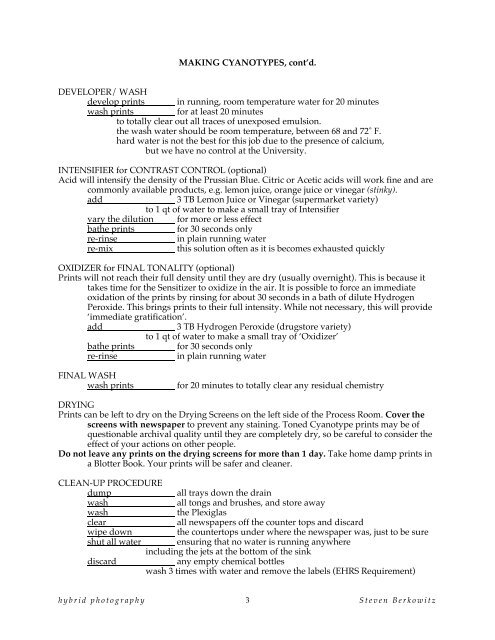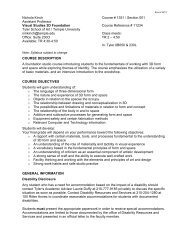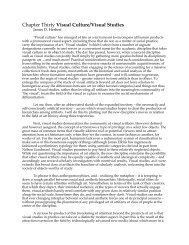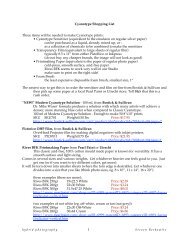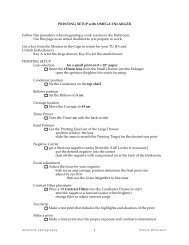Making Cyanotypes - Berkowitz - Educational Pages
Making Cyanotypes - Berkowitz - Educational Pages
Making Cyanotypes - Berkowitz - Educational Pages
Create successful ePaper yourself
Turn your PDF publications into a flip-book with our unique Google optimized e-Paper software.
MAKING CYANOTYPES, cont’d.<br />
DEVELOPER/ WASH<br />
develop prints in running, room temperature water for 20 minutes<br />
wash prints for at least 20 minutes<br />
to totally clear out all traces of unexposed emulsion.<br />
the wash water should be room temperature, between 68 and 72˚ F.<br />
hard water is not the best for this job due to the presence of calcium,<br />
but we have no control at the University.<br />
INTENSIFIER for CONTRAST CONTROL (optional)<br />
Acid will intensify the density of the Prussian Blue. Citric or Acetic acids will work fine and are<br />
commonly available products, e.g. lemon juice, orange juice or vinegar (stinky).<br />
add 3 TB Lemon Juice or Vinegar (supermarket variety)<br />
to 1 qt of water to make a small tray of Intensifier<br />
vary the dilution for more or less effect<br />
bathe prints for 30 seconds only<br />
re-rinse in plain running water<br />
re-mix this solution often as it is becomes exhausted quickly<br />
OXIDIZER for FINAL TONALITY (optional)<br />
Prints will not reach their full density until they are dry (usually overnight). This is because it<br />
takes time for the Sensitizer to oxidize in the air. It is possible to force an immediate<br />
oxidation of the prints by rinsing for about 30 seconds in a bath of dilute Hydrogen<br />
Peroxide. This brings prints to their full intensity. While not necessary, this will provide<br />
‘immediate gratification’.<br />
add 3 TB Hydrogen Peroxide (drugstore variety)<br />
to 1 qt of water to make a small tray of ‘Oxidizer’<br />
bathe prints for 30 seconds only<br />
re-rinse in plain running water<br />
FINAL WASH<br />
wash prints for 20 minutes to totally clear any residual chemistry<br />
DRYING<br />
Prints can be left to dry on the Drying Screens on the left side of the Process Room. Cover the<br />
screens with newspaper to prevent any staining. Toned Cyanotype prints may be of<br />
questionable archival quality until they are completely dry, so be careful to consider the<br />
effect of your actions on other people.<br />
Do not leave any prints on the drying screens for more than 1 day. Take home damp prints in<br />
a Blotter Book. Your prints will be safer and cleaner.<br />
CLEAN-UP PROCEDURE<br />
dump all trays down the drain<br />
wash all tongs and brushes, and store away<br />
wash the Plexiglas<br />
clear all newspapers off the counter tops and discard<br />
wipe down the countertops under where the newspaper was, just to be sure<br />
shut all water ensuring that no water is running anywhere<br />
including the jets at the bottom of the sink<br />
discard any empty chemical bottles<br />
wash 3 times with water and remove the labels (EHRS Requirement)<br />
hybrid photography 3<br />
Steven <strong>Berkowitz</strong>


